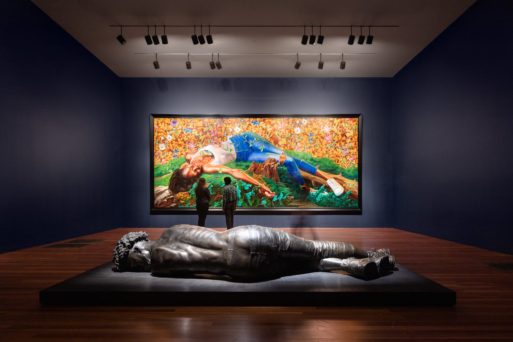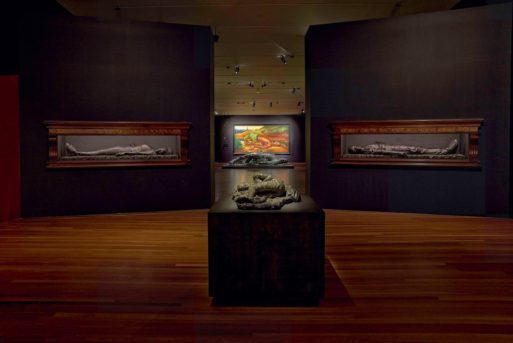
An installation view of An Archaeology of Silence at the de Young Museum
Credit: Fine Arts Museums of San Francisco
Classic art is no stranger to depicting death. Scenes of a martyred Jesus and other saints dominated art for centuries, interspersed with a fascination with painting other tableaus of death and violence such as Socrates ingesting poison, Greek heroes felled in battle, or Ophelia drowned in water. But much of Western art was dominated by painting white bodies.”An Archaeology of Silence,” a new exhibit by Kehinde Wiley, seeks to change that.
Kehinde Wiley’s newest exhibit takes inspiration from classical art to depict black bodies who are dead or dying. Wiley’s 2008 collection, “DOWN,” offered large-scale, opulent images of dead Black men, drawn in the style of Holbein’s “The Dead Christ in the Tomb.” Wiley’s latest exhibit combines those paintings with new bronze figures and portraits and continues to shine light on the systems of oppression that lead to unnecessary killings of brown and Black people. The paintings and sculptures portray their subjects as peaceful, heroic and worthy of closer examination. By using poses from well-known classical art, Wiley inserts the Black experience of death from the legacies of colonialism and system racism into the ongoing narrative of what it means to depict life and death in art. Wiley spoke with Art Daily about the work, stating,
“While this work is not specifically about tomb effigies, it does relate to death, mortality, powerlessness, and the downcast figure — the juxtaposition of death and decay in the midst of a narrative of youth and redemption. It is an expression of my desire to depict the struggles of Black and Brown youth globally, through the rubric of violence and power.”

One of Wiley’s paintings on exhibit through “An Archaeology of Silence”
Credit: kehindewiley.com
With the nature of the exhibit, one might assume it would be excessively gruesome or based on shock value, but instead, the combination of Wiley’s signature bright floral backgrounds, and the stillness of the bronze sculptures, lends it an air of sacredness. Wiley avoids graphic references to death, dying or blood, and instead focuses on the fallen humanity of these brown bodies. He depicts them as martyrs. The exhibit’s first destination, the de Young Museum in San Francisco, offers this to visitors encountering the exhibit for the first time: “Wiley investigates the iconography of death and sacrifice in Western art, tracing it across religious, mythological, and historical subjects. In “An Archaeology of Silence,” the senseless deaths of men and women around the world are transformed into a powerful elegy of resistance.”
An “Archaeology of Silence” will be rotating through the de Young Museum in San Francisco, the Museum of Fine Arts in Houston, the Pérez Art Museum in Miami, and the Minneapolis Institute of Art until 2025.

Larger than life paintings and sculptures define “An Archaeology of Silence.”
Credit: Fine Arts Museums of San Francisco

 “An Archaeology of Silence” by Kehinde Wiley
“An Archaeology of Silence” by Kehinde Wiley


 How Dare You Die Now!
How Dare You Die Now!
 Debating Medical Aid in Dying
Debating Medical Aid in Dying
 “Help Me, Helen”
“Help Me, Helen”














